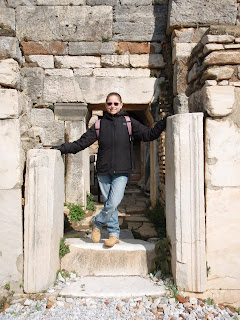Tuesday, May 17, 2011 - 
 No comments
No comments

 No comments
No comments
ARCA 2011 Student Margaret Wade on Sculpture, The Third Reich and Art, and the 'Unregulated Aspect of the Art World'
 |
| Plaster cast self-portrait by Margaret Wade from her first art show |
Margaret Wade: I began studying the theory and psychology of Art (specifically Sculpture) at a small, liberal arts school in Amherst, MA. This is how I came across my second major- The Third Reich. Hitler, an artist, understood that to truly destroy a culture, among other things, he must eliminate the very threads that unite a society- its expression. At my second school, Mount Holyoke, I dove into Art History in the Third Reich and Art Studio. It was here I realized that I cannot fix the past, but I can contribute to the future. All the Nazi looted art work deserves to be to returned to its rightful owner. Plus, when I grow up, I want to be Indiana Jones.
I am also interested in the idea of containment and preservation. How do you encapsulate the moment, memory and effect of art? Databasing and cataloguing art will help with my second path- I am creating a "museum" out of the house I grew up in. Located in Birmingham, AL, I plan to share with my community a purple house with snakes and chairs on the ceiling, and its contemporary art.ARCA Blog: Do you have a current fascination with an artist or period of art?
Margaret Wade: Any piece of art with a pulse will strike my interest. Historically, I enjoy Dadaism and Surrealism because of the boundaries Duchamp pushed the art world. As of right this moment in time, Street art gets my heart racing. I love the unregulated aspect of the art world. As an artist, I am constantly seeking out new areas of expression. Who owns art anyway?ARCA Blog: Have you traveled or lived in Italy and what would you like to do there when you are not attending lectures?
Margaret Wade: In 2007, I had the pleasure of working with the Peggy Guggenheim Museum in Venice for three months. I got to experience the art world in ways an artist or art historian is not privy to. I believe to be truly passionate about an area of work, you must experience it all. Working in a museum, you come to understand the affect art has on its visitors- vandalism, utter amazement, disgust, indifference. It is this reason I plan to pursue, Why in the world would you steal an piece of art work? It is just an object -- an object that causes people to react in so many different way that I just want to know WHY. If I ever stop questioning and searching for answers, consider me dead!ARCA Blog: Amelia has many venues for playing live music. Are you a musician?
Margaret Wade: HA! Absolutely not, I cannot carry a tune, but I can dance for hours HOURS on end. In fact, Karaoke is one of my biggest fears. That said, I appreciate all aspects of art- even the ones that highlight my flaws! I enjoy experiencing new sensations and getting lost in music. Life is a priviledge but art is a right!










